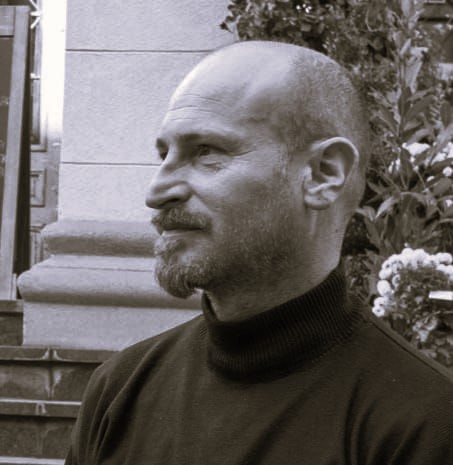Andrej Mitevski (1976) is a visionary Macedonian sculptor whose artwork has been exhibited in China (2008, 2022), Japan (2007), the Netherlands (2006), Greece (2014, 2015, 2016), Serbia (2008, 2023), Montenegro (2022), and in various Macedonian art museums and galleries.
A Marvel in Marble.
Andrej carves abstract and figurative life forms, such as leaves, feathers, cobwebs, honeycombs, as well as natural patterns and ethereal shapes. One of the hallmark elements of his sculptures is the finely entwined three-dimensional curves in marble, which leave us marveling at the artist’s skill to gently shape stone into intricate, living flows.
He prefers marble and feels a special connection to it, but he also enjoys working with onyx and travertine. Although large sculptures require heavy-duty machinery, Andrej loves the intimacy of hand tools, especially when working on delicate details.
“I try to elicit the tenderness of the stone,” says this Stone Whisperer. “The stone speaks to me, and I listen. It tells me which shape it wants to become, where to cut, and how to work with it.”

Contemporary Vestiges
Andrej Mitevski draws his inspiration from the distant territories of Antiquity. From this powerful lineage, he creates sculptures full of grace and elegance. An ode to femininity.
Antiquity is an El Dorado for art lovers like us. The masterpieces left to us by the centuries have an incredible allure, leaving a lasting impression on our minds. These works, such as the Winged Victory of Samothrace, Praxiteles’ Hermes, the Venus de Milo, and Myron’s Discobolus, are only a few examples. With his new series entitled “Torsos,” Andrej Mitevski invites us to an emotional confrontation with the forms inherited from this glorious past—a return to the sources, in a sense.
“I walk in the most distant antiquity. I want to connect the past to the present, to recall, to judge, and to complete,” said Auguste Rodin. In a similar approach, Andrej Mitevski roots his sculpture in ancient territories, drawing inspiration from them. The silhouettes that emerge from the stone blocks he delicately carves are familiar in many ways. Let’s admit it: they seem to emanate from a time when the world was still in its infancy, expressed by artists of that era with unparalleled mastery.
Andrej Mitevski has so deeply absorbed the works of the great ancients that he has resurrected their spirit. His sculpture is a homage. Observing it closely is like traveling back through centuries, abolishing time, and feeling the strange sensation of being closest to the History of Art. His female torsos, deliberately deprived of their limbs as often seen in the remnants of ancient Greek statuary, radiate a troubling poetry.
However, let there be no mistake. Andrej Mitevski’s art, while indeed a subtle interpretation of past art (a kind of hermeneutics applied to sculpture), invests the stone with a movement full of grace and lightness that draws from our present an abstract, radical, and as refined inspiration as possible. His female torsos, with their effective stylization, restore with sobriety the beauty of elongated women’s bodies. I see a magnificent nod and an obvious aesthetic boldness to the passing time, which, mastered by the artist, embellishes rather than damages. Andrej Mitevski’s sculptures are animated by an inner strength and a discreet movement that make them unique and vibrant.
Like his distant predecessors, the sculptor places the body (mainly of women) at the center of the game. His “torsos” are bridges laid across the centuries, invitations to wander between myth and reality.
Ludovic Duhamel – Editor-in-Chief, Miroir de l’Art Magazin
| Solo Exhibitions : | Symposiums of Sculpture : |
| 2024 – Sakura Festival, Skopje, Macédoine | 2021 – Cairo International Sculpture Symposium, Egypte |
| 2023 – Differdange International Sculpture Symposium, Luxembourg | 2019 – Hurghada International Sculpture Symposium, Egypte |
| 2021 – Europe House, Strumica, Macédoine | 2018 – Aiud International Sculpture Symposium, Roumanie |
| 2020 – Skopje, Macédoine | 2018 – Korca Parks International Sculpture Symposium, Albanie |
| 2018 – Ostraka Arts International Sculpture Symposium, Egypte | 2016 – Sao Jose International Sculpture Symposium, Brésil |
| 2016 – MYRO Gallery, Thessalonique, Grèce | 2015 – Drum de Brankusi International Sculpture Symposium, Craiova, Roumanie |
| 2012 – Gallery “OKO”, Skopje, Macédoine | 2015 – International Sculpture Symposium, Braila, Roumanie |
| 2009 – Museum of the City of Skopje, Macédoine | 2015 – International Sculpture Symposium, Prilep, Macédoine |
| 2008 – Galerija “Kolarac”, Belgrade, Serbie | 2014 – Caransebes Sculpture Symposium, Roumanie |
| 2006 – Babel Centre of Contemporary Art, Utrecht, Pays-Bas | 2013 – Shumadija Granite Symposium, Arangelovac, Serbie |
| 2003 – Museum of Contemporary Art, Skopje, Macédoine | 2013 – Sculpture Symposium, Panevezus, Lituanie |
| 2000 – House of Robevci, Ohrid, Macédoine | 2013 – Outdoor Sculpture Symposium, Guandu Park, Taipei, Taïwan |
| 1999 – CIX Gallery, Skopje, Macédoine | 2013 – Greek Marble Initiative, Grèce |
| 2011 – International Sculpture Symposium, Santiago del Estero, Argentine | |
| 2008 – Coreno Ausonia, Italie | |
| 2007 – Roca di Archi International Sculpture Symposium, Italie | |
| 2006 – Nasunogahara International Sculpture Symposium, Otawara, Japon | |
| 2004 – Roca di Archi, San Giovanni Incarico, Valemaio, Italie | |
| 2000 – Cervara di Roma, Italie | |
| 1999 – Atina, Italie | |
| 1999 – Valemaio, Italie | |
| 1997-1998 – Prilep, Macédoine |
To provide the best experiences, we use technologies such as cookies to store and/or access device information. Consent to these technologies will allow us to process data such as browsing behavior or unique IDs on this site. Not giving or withdrawing consent may have a negative effect on certain features and functions.